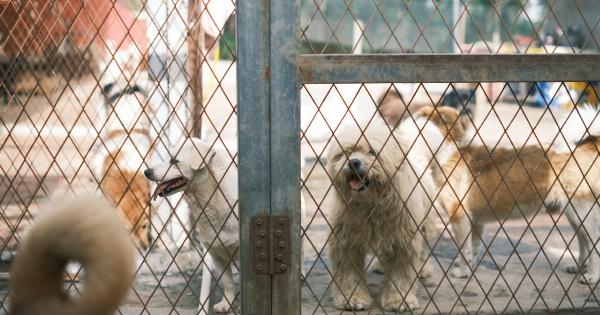Dogs are known to be loyal and loving companions, but understanding their emotions can sometimes be a challenge. Unlike humans, who rely heavily on verbal communication, dogs primarily communicate through body language and vocalizations.
By learning to interpret their cues and signals, we can deepen our bond with our furry friends and ensure their emotional well-being. In this article, we will explore the language of love that dogs speak and provide you with valuable insights into understanding your dog’s emotions.
1. Tail Wagging: Not All Wagging is Created Equal
One of the most iconic dog behaviors, tail wagging, can convey various emotions depending on the context. While it is often associated with happiness or excitement, a tail tucked between the legs can indicate fear or submission.
Additionally, a fast and wide wag typically signifies joy, whereas a slow and rigid wag might indicate caution or insecurity. Pay attention to these subtle differences to better comprehend your dog’s emotional state.
2. Facial Expressions: Eyes, Ears, and Mouth
A canine’s face can tell a thousand tales. By observing their eyes, ears, and mouth, we can gain significant insights into their emotional well-being.
Dilated pupils can indicate excitement or fear, while narrowed eyes may suggest aggression or uneasiness. Similarly, forward-facing ears often signal attentiveness, while backward or flattened ears may indicate anxiety or fear.
Keep an eye on your dog’s mouth as well – a relaxed, slightly open mouth signifies contentment, while a tightly closed mouth can imply tension or stress.
3. Body Posture: The Power of Positioning
Dogs communicate volumes through their body posture and positioning. A confident dog usually stands tall with its weight evenly distributed on all four legs.
On the other hand, a fearful dog might crouch or lower its body to appear smaller and less threatening. Pay attention to other cues like the stiffness or looseness of their muscles, as well as any signs of aggression such as raised hackles or a stiff, wagging tail.
Understanding these cues will help you gauge your dog’s emotional state and respond accordingly.
4. Vocalizations: Barks, Whines, and More
Dogs have a diverse range of vocalizations, each conveying a different emotion or message. Barking is a common form of communication and can denote excitement, fear, or alertness, depending on its pitch and intensity.
Whining or whimpering often indicates discomfort or anxiety, whereas growling suggests aggression or protection. Understanding the different vocalizations will assist you in determining what your dog is trying to convey.
5. Social Behaviors: Play, Affection, and Aggression
Observing how your dog interacts with you, other animals, and its surroundings is crucial in understanding their emotional state.
Playful behaviors such as bowing, pouncing, and wagging their tail while interacting with you indicate happiness and affection. In contrast, avoidance, growling, or snapping may suggest fear, anxiety, or aggression. Recognizing your dog’s social cues will help you foster a safe and harmonious environment for them.
6. Scent Marking: Establishing Ownership
Scent marking is an instinctual behavior in dogs that allows them to establish territories and communicate with other animals. Common methods of scent marking include urinating on vertical surfaces or scratching the ground.
While scent marking is primarily used for communication with other dogs, it also helps your dog feel secure and assert ownership. Understanding this behavior will enable you to distinguish between territorial marking and inappropriate elimination in the house.
7. Energy Levels: The Power of Play and Rest
Just like humans, dogs have varying energy levels that reflect their emotional state. A dog with high-energy, bouncing off the walls, may be expressing excitement or anxiety.
On the other hand, a lethargic or withdrawn dog could be experiencing sadness or illness. Pay attention to your dog’s energy levels and provide appropriate mental and physical stimulation to maintain a healthy balance.
8. Physical Contact: Cuddles, Licking, and Tail Wagging
Dogs often seek physical contact as a means of companionship and emotional support. Tail wagging combined with leaning against you or licking your face is a clear indication of affection and happiness.
However, some dogs may display signs of discomfort, such as avoiding touch or recoiling, when they are feeling anxious or fearful. Respect your dog’s boundaries and be attuned to their physical responses during interactions.
9. Environmental Awareness: Sensitivity to Surroundings
Dogs have a keen sense of awareness when it comes to their surroundings. They may exhibit behaviors like barking, pacing, or hiding when they sense potential danger or feel overwhelmed by their environment.
By understanding the triggers that can cause stress or anxiety in your dog, you can create a safe space and employ strategies such as desensitization to help them feel more secure.
10. The Power of Positive Reinforcement: Strengthening the Bond
Positive reinforcement plays a crucial role in shaping your dog’s emotional well-being. Rewarding desirable behaviors with treats, praise, and playtime helps establish trust and strengthens the bond between you and your furry companion.
Conversely, punishment and harsh training techniques can lead to fear, anxiety, and aggression. Emphasize positive reinforcement in your training and interaction to foster a healthy and emotionally balanced dog.


























